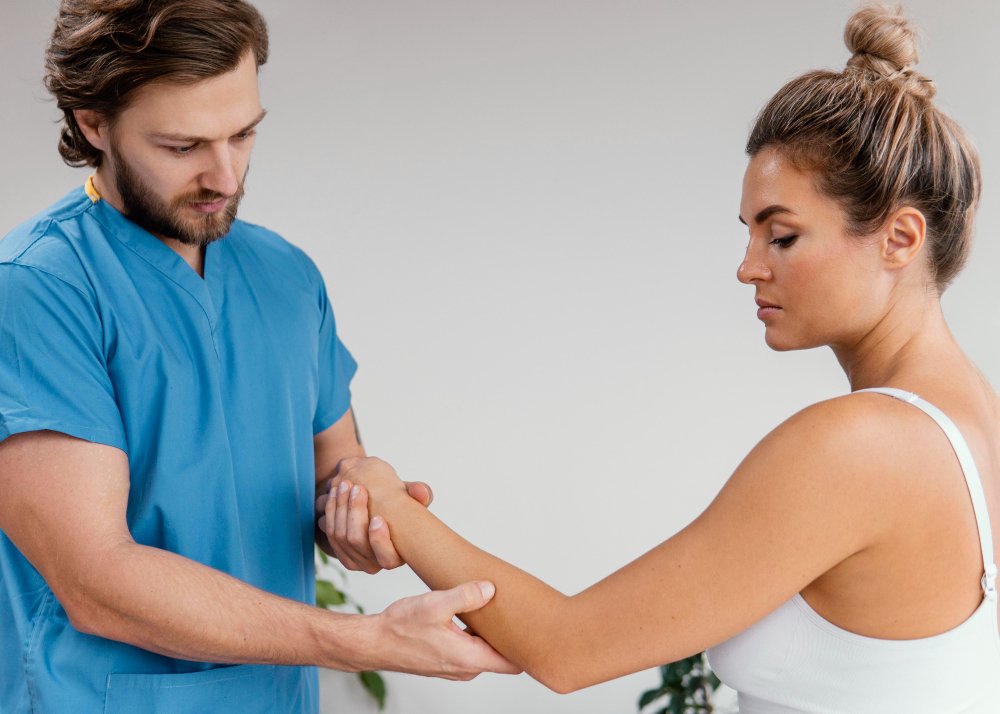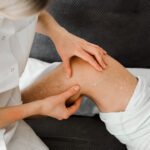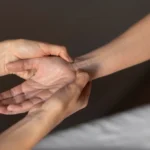Joint pain is one of the most common health issues worldwide, affecting people of all ages, ranging from mild stiffness to severe arthritis. While conventional treatments might offer temporary relief, they don’t address the root cause.
Ayurvedic treatment for joint pain helps relieve pain and inflammation, restores dosha balance, improves joint lubrication, and nourishes tissues. Ayurveda offers long-term solutions with herbal formulations, therapies, oils, and lifestyle changes.
Understanding Joint Pain in Ayurveda
Joint pain, or arthralgia, refers to discomfort or pain felt in one or more joints. It can arise from inflammatory conditions such as arthritis or mechanical issues such as wear and tear.
According to Ayurveda, joint pain can be attributed to an imbalance in doshas, primarily vata dosha, which is responsible for movement and circulation. When Vata dosha becomes aggravated, it causes dryness, stiffness, and restricted mobility in the joints. Additionally, poor digestion weakens the Agni (digestive fire), leading to the accumulation of ama (toxins). These toxins accumulate in the joints, resulting in inflammation, swelling, and persistent pain.
Common Types of Joint Pain and Arthritis
Joint pain can arise from various conditions, ranging from degenerative wear and tear to autoimmune and inflammatory disorders. Common conditions include:
Osteoarthritis
A degenerative joint condition where cartilage gradually wears down, leading to pain, stiffness, swelling, and reduced mobility. It is the most common cause of joint pain, particularly in older adults.
Rheumatoid Arthritis
An autoimmune disorder in which the immune system mistakenly attacks joint tissues, causing chronic inflammation, pain, and deformity over time.
Gout
Triggered by the accumulation of uric acid crystals in the joints, gout presents as sudden, intense pain and swelling and commonly affects the big toe, ankles, or knees.
Psoriatic Arthritis
A form of arthritis seen in people with psoriasis. It causes joint inflammation along with skin symptoms. It can also affect connective tissues where tendons and ligaments attach to bones.
Ankylosing Spondylitis
A type of inflammatory arthritis that primarily affects the spine and sacroiliac joints, leading to stiffness, reduced flexibility, and, in severe cases, fusion of the vertebrae.
Juvenile Idiopathic Arthritis
The most common type of chronic arthritis in children, marked by joint swelling, stiffness, and pain that can persist into adulthood.
Other Common Causes of Joint Pain
- Bursitis: Inflammation of bursae (small fluid-filled sacs that cushion joints).
- Tendinitis: Inflammation or irritation of tendons, usually due to overuse or injury.
- Injuries: Sprains, strains, and fractures can all cause acute or long-term joint pain.
- Overuse: Repetitive movements or poor posture may strain muscles and joints.
- Infections: Conditions such as septic arthritis (infection inside a joint) or osteomyelitis (bone infection) can cause severe joint inflammation.
You may also like: Ayurvedic treatment for vitiligo
Ayurvedic Medicines and Herbs for Joint Pain
Ayurvedic treatment for joint pain involves a combination of Panchakarma therapies, herbal formulations, a tailored diet, and lifestyle adjustments. These work together to balance the doshas, expel toxins, reduce inflammation, and restore overall harmony in the body.
Ayurvedic Herbs
- Ashwagandha (Withania somnifera): Known for its rejuvenating properties, it reduces inflammation, strengthens bones and muscles, and improves joint flexibility.
- Shallaki (Boswellia serrata): A powerful anti-inflammatory herb that prevents cartilage damage and relieves stiffness in arthritis.
- Guggulu (Commiphora mukul): Known for its anti-arthritic effects, it reduces swelling, relieves pain, and clears toxins.
- Nirgundi (Vitex negundo): Effective in reducing pain and stiffness.
- Guduchi (Tinospora cordifolia): Boosts immunity, detoxifies the body, and reduces joint inflammation.
- Eranda (Castor oil): Used internally and externally for its strong Vata-pacifying properties, helping relieve stiffness and constipation often associated with arthritis.
- Turmeric (Haridra): Rich in curcumin, it acts as a natural anti-inflammatory and supports cartilage health.
Classical Ayurvedic Formulations for Joint Pain
- Yogaraja Guggulu: Considered one of the best Ayurvedic medicines for joint pain, useful in arthritis, stiffness, and degenerative changes.
- Simhanada Guggulu: Combines Guggulu with castor oil, excellent for reducing Ama and inflammation in rheumatoid arthritis.
- Maharasnadi Kashayam and Rasnerandadi Kashayam: Decoctions that relieve stiffness, swelling, and pain in multiple joints.
- Sahacharadi Kashayam: Commonly used in low back pain and sciatica.
- Dasamoolarishtam: A liquid formulation, known for its Vata-pacifying and anti-inflammatory properties.
- Gandha Thaila: Supports bone strength, lubricates joints, and reduces stiffness when taken with milk or decoctions.
Kerala Ayurvedic Oils & Therapies for Joint Pain
Ayurvedic oils play a major role in balancing vitiated doshas and improving joint mobility:
- Mahanarayana Thailam: Helps relieve pain, reduces stiffness, and supports joint mobility.
- Kottamchukkadi Thailam: Helps reduce swelling and improves flexibility.
- Dhanwantharam Thailam: Strengthens muscles and nerves.
- Sahacharadi Thailam: Relieves stiffness in the lower back, hips, and legs; often recommended in sciatica and spondylosis.
- Prasarinyadi Thailam: Traditionally prescribed for conditions like frozen shoulder (Avabahuka) and joint immobility.
Ayurveda incorporates a combination of internal and external therapies to restore joint movement and improve joint mobility:
- Abhyanga (Full Body Oil Massage): A warm oil massage that reduces stiffness, improves circulation, and prevents degeneration of joints.
- Pizhichil: Warm medicated oils are poured continuously over the body, deeply nourishing the joints and muscles.
- Elakizhi: Warm poultices filled with medicinal leaves are applied to inflamed joints, easing stiffness and swelling.
- Jambeera Pinda Sweda: Heated lemon boluses with herbal powders are massaged on affected joints to reduce pain and inflammation.
- Shashtika Shali Pinda Sweda: A nourishing therapy using medicated rice boluses, excellent for strengthening joints and preventing degeneration.
- Nadi Sweda: Application of herbal steam to painful joints improves flexibility and relieves stiffness.
- Basti (Medicated Enema): Considered one of the most effective Panchakarma therapies for joint disorders, as it directly pacifies aggravated Vata.
- Nasya: Beneficial for stiffness and pain in the upper body, especially shoulders and neck.
You may also like: Ayurvedic treatment for eyesight
Ayurvedic Diet and Lifestyle for Joint Health
Dietary Guidelines
- Favor warm, freshly cooked meals to keep Vata dosha in balance.
- Add antioxidant- and anti-inflammatory-rich foods, including berries and leafy greens, to reduce inflammation and support joint strength.
- Include healthy fats such as ghee, sesame oil, and olive oil to nourish tissues and prevent joint dryness.
- Follow a balanced diet with fruits, vegetables, whole grains, and lean proteins to strengthen bones and muscles.
- Use Ayurvedic spices, including turmeric, cumin, and coriander, to improve digestion and naturally ease inflammation.
- Limit processed foods, refined sugars, and alcohol, which can worsen stiffness and inflammation.
- Stay hydrated with warm water and herbal teas to maintain proper joint lubrication.
Lifestyle Tips
- Maintain a healthy weight to reduce pressure and wear on the joints.
- Avoid prolonged periods of sitting or standing to prevent stiffness.
- Choose supportive footwear; avoid high heels and poorly cushioned shoes.
- Engage in gentle exercises such as yoga, stretching, or walking to improve flexibility without straining the joints.
- Practice good posture while sitting, standing, and working to reduce stress on the spine and joints.
Preventive Measures for Long-Term Joint Care
- Seasonal Panchakarma: Undergo periodic Panchakarma therapies to expel toxins and keep joints healthy. You can visit Back to Roots for seasonal Ayurvedic retreat in Kerala.
- Regular Abhyanga: Weekly oil massage with medicated oils prevents stiffness, nourishes tissues, and slows degeneration.
- Rasayana Therapy: Use rejuvenative herbs such as Ashwagandha, Guduchi, and Amalaki to strengthen bones and delay age-related wear.
- Early Care: Address minor stiffness or pain promptly with Ayurvedic guidance to prevent progression into chronic arthritis.
- Low-Impact Activity: Engage in joint-friendly exercises such as swimming, cycling, or gentle yoga to maintain mobility without strain.
- Balanced Rest & Work: Avoid overexertion. Maintaining moderation is key to joint longevity.
Joint pain can deeply affect daily life, but Ayurveda provides a holistic and long-term approach that goes beyond just masking symptoms. By addressing the root cause through herbal remedies, rejuvenating oils, Panchakarma therapies, and lifestyle corrections, Ayurveda helps restore balance, nourish tissues, and protect joint health for years to come.
Our expert Ayurvedic doctors assess your unique body constitution (Prakriti) and identify dosha imbalances to create a customized treatment plan. This may include classical herbal medicines, rejuvenating oils, Panchakarma detox therapies, and lifestyle modifications designed to reduce pain, restore flexibility, and strengthen your joints naturally.
Whether you are struggling with arthritis, stiffness, or long-term mobility issues, our goal is to help you move with ease. Book your consultation today at Back To Roots Ayurvedic Clinic to experience Ayurvedic treatment in Kerala and take the first step toward pain-free, active living.
1. What is the best Ayurvedic medicine for joint pain?
The best Ayurvedic medicines for joint pain include Yogaraja Guggulu, Simhanada Guggulu, Sahacharadi Kashayam, and Maharasnadi Kashayam. Always consult an Ayurvedic physician before consuming Ayurvedic formulations.
2. Which Ayurvedic oil is good for knee pain?
Mahanarayana Thailam and Kottamchukkadi Thailam are widely used for knee and joint pain.
3. Can Ayurveda cure arthritis permanently?
Ayurveda offers long-term relief by balancing doshas, reducing inflammation, and preventing recurrence, though results vary with severity.
4. How long does it take to see results with Ayurvedic joint treatments?
Mild cases may improve in 4 to 6 weeks, while chronic arthritis may require 3 to 6 months of treatment including Panchakarma.
5. Are there side effects of Ayurvedic medicine for joint pain?
When prescribed by a qualified Ayurvedic doctor, herbal medicines are generally safe and free from harmful side effects.







